Finance in Hospitality: Transactions, Information, and Analysis
VerifiedAdded on 2023/03/31
|9
|2348
|115
Case Study
AI Summary
This assignment covers various aspects of finance in the hospitality industry, including defining assets, liabilities, equity, cost of sales, income, and expenses with relevant examples. It discusses financial reporting methods, fixed and variable costs, and key business performance indicators. The assignment also explores source documents, journal entries, transaction reports, and the importance of regular financial information review. It delves into double-entry bookkeeping rules and common accounting software like FRESHBOOKS. Furthermore, it includes a research project defining ledgers, subsidiary ledgers, receipts, disbursements, accounts payable, debtors, creditors, and cash flow, along with specific hospitality concepts like guest accounts, inventory, and revenue management, and GST reporting requirements. Finally, a case study analyzes the debt ratio, equity ratio, current ratio, gross profit margin, and net profit margin for Fat Freddie’s Fab Frogs, providing insights into the company's financial performance.
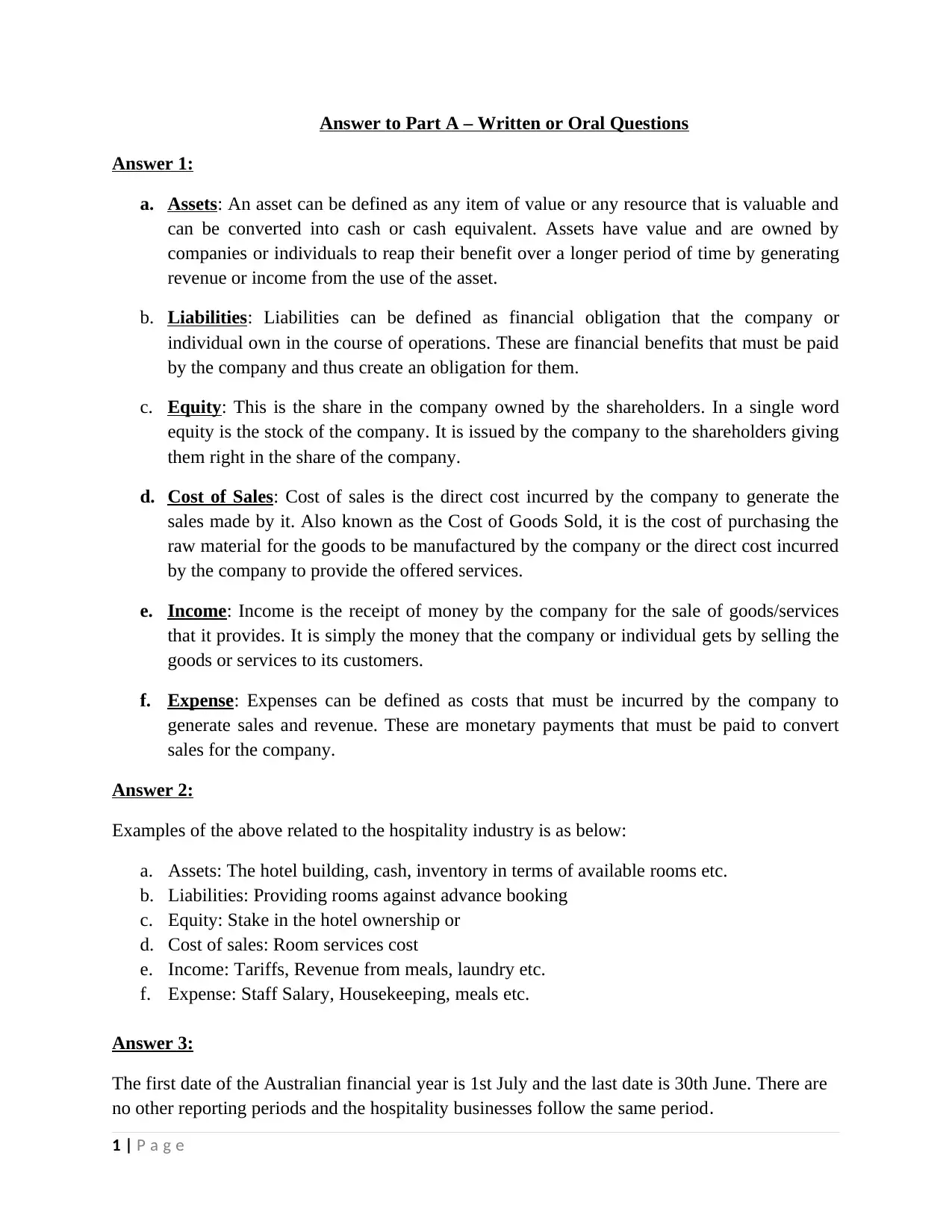
Answer to Part A – Written or Oral Questions
Answer 1:
a. Assets: An asset can be defined as any item of value or any resource that is valuable and
can be converted into cash or cash equivalent. Assets have value and are owned by
companies or individuals to reap their benefit over a longer period of time by generating
revenue or income from the use of the asset.
b. Liabilities: Liabilities can be defined as financial obligation that the company or
individual own in the course of operations. These are financial benefits that must be paid
by the company and thus create an obligation for them.
c. Equity: This is the share in the company owned by the shareholders. In a single word
equity is the stock of the company. It is issued by the company to the shareholders giving
them right in the share of the company.
d. Cost of Sales: Cost of sales is the direct cost incurred by the company to generate the
sales made by it. Also known as the Cost of Goods Sold, it is the cost of purchasing the
raw material for the goods to be manufactured by the company or the direct cost incurred
by the company to provide the offered services.
e. Income: Income is the receipt of money by the company for the sale of goods/services
that it provides. It is simply the money that the company or individual gets by selling the
goods or services to its customers.
f. Expense: Expenses can be defined as costs that must be incurred by the company to
generate sales and revenue. These are monetary payments that must be paid to convert
sales for the company.
Answer 2:
Examples of the above related to the hospitality industry is as below:
a. Assets: The hotel building, cash, inventory in terms of available rooms etc.
b. Liabilities: Providing rooms against advance booking
c. Equity: Stake in the hotel ownership or
d. Cost of sales: Room services cost
e. Income: Tariffs, Revenue from meals, laundry etc.
f. Expense: Staff Salary, Housekeeping, meals etc.
Answer 3:
The first date of the Australian financial year is 1st July and the last date is 30th June. There are
no other reporting periods and the hospitality businesses follow the same period.
1 | P a g e
Answer 1:
a. Assets: An asset can be defined as any item of value or any resource that is valuable and
can be converted into cash or cash equivalent. Assets have value and are owned by
companies or individuals to reap their benefit over a longer period of time by generating
revenue or income from the use of the asset.
b. Liabilities: Liabilities can be defined as financial obligation that the company or
individual own in the course of operations. These are financial benefits that must be paid
by the company and thus create an obligation for them.
c. Equity: This is the share in the company owned by the shareholders. In a single word
equity is the stock of the company. It is issued by the company to the shareholders giving
them right in the share of the company.
d. Cost of Sales: Cost of sales is the direct cost incurred by the company to generate the
sales made by it. Also known as the Cost of Goods Sold, it is the cost of purchasing the
raw material for the goods to be manufactured by the company or the direct cost incurred
by the company to provide the offered services.
e. Income: Income is the receipt of money by the company for the sale of goods/services
that it provides. It is simply the money that the company or individual gets by selling the
goods or services to its customers.
f. Expense: Expenses can be defined as costs that must be incurred by the company to
generate sales and revenue. These are monetary payments that must be paid to convert
sales for the company.
Answer 2:
Examples of the above related to the hospitality industry is as below:
a. Assets: The hotel building, cash, inventory in terms of available rooms etc.
b. Liabilities: Providing rooms against advance booking
c. Equity: Stake in the hotel ownership or
d. Cost of sales: Room services cost
e. Income: Tariffs, Revenue from meals, laundry etc.
f. Expense: Staff Salary, Housekeeping, meals etc.
Answer 3:
The first date of the Australian financial year is 1st July and the last date is 30th June. There are
no other reporting periods and the hospitality businesses follow the same period.
1 | P a g e
Paraphrase This Document
Need a fresh take? Get an instant paraphrase of this document with our AI Paraphraser
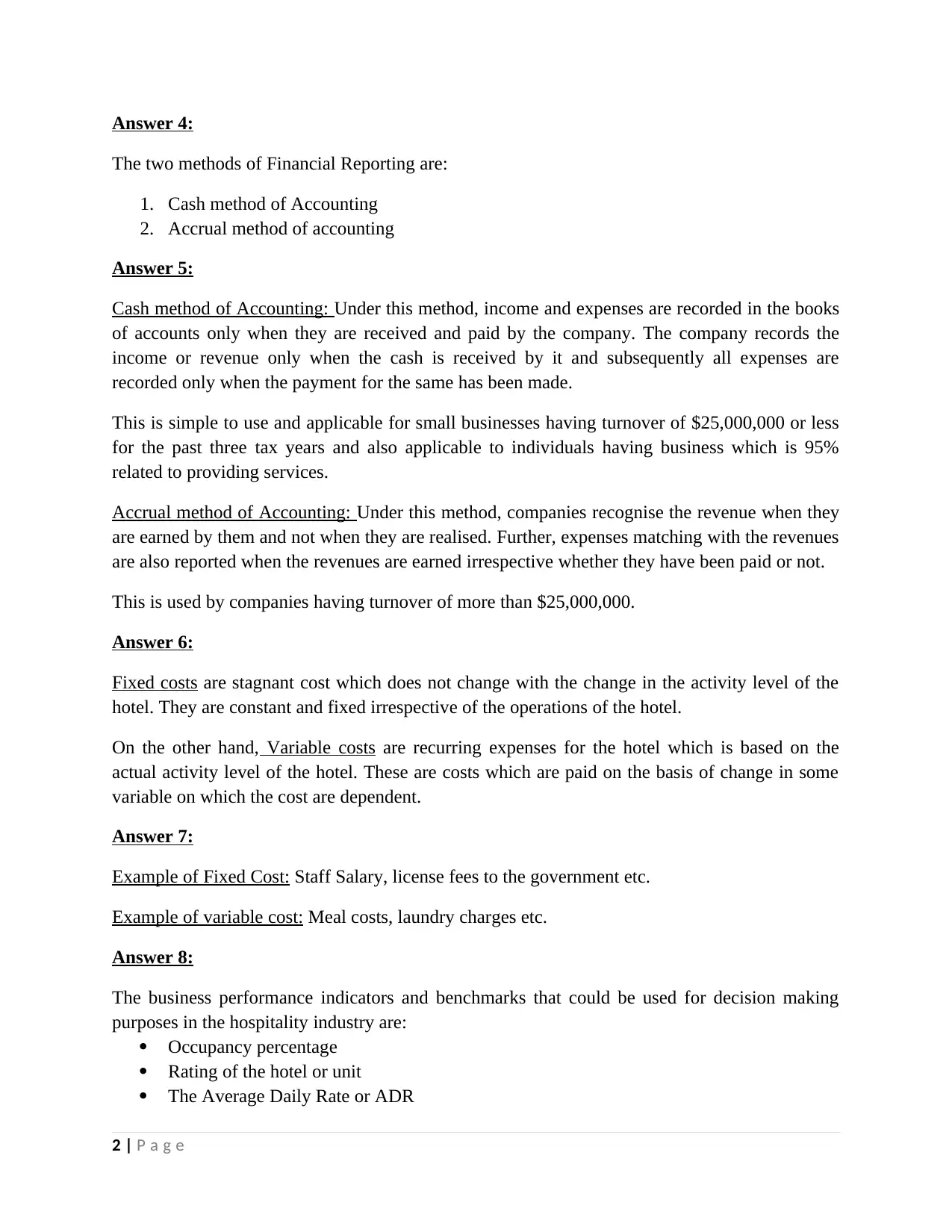
Answer 4:
The two methods of Financial Reporting are:
1. Cash method of Accounting
2. Accrual method of accounting
Answer 5:
Cash method of Accounting: Under this method, income and expenses are recorded in the books
of accounts only when they are received and paid by the company. The company records the
income or revenue only when the cash is received by it and subsequently all expenses are
recorded only when the payment for the same has been made.
This is simple to use and applicable for small businesses having turnover of $25,000,000 or less
for the past three tax years and also applicable to individuals having business which is 95%
related to providing services.
Accrual method of Accounting: Under this method, companies recognise the revenue when they
are earned by them and not when they are realised. Further, expenses matching with the revenues
are also reported when the revenues are earned irrespective whether they have been paid or not.
This is used by companies having turnover of more than $25,000,000.
Answer 6:
Fixed costs are stagnant cost which does not change with the change in the activity level of the
hotel. They are constant and fixed irrespective of the operations of the hotel.
On the other hand, Variable costs are recurring expenses for the hotel which is based on the
actual activity level of the hotel. These are costs which are paid on the basis of change in some
variable on which the cost are dependent.
Answer 7:
Example of Fixed Cost: Staff Salary, license fees to the government etc.
Example of variable cost: Meal costs, laundry charges etc.
Answer 8:
The business performance indicators and benchmarks that could be used for decision making
purposes in the hospitality industry are:
Occupancy percentage
Rating of the hotel or unit
The Average Daily Rate or ADR
2 | P a g e
The two methods of Financial Reporting are:
1. Cash method of Accounting
2. Accrual method of accounting
Answer 5:
Cash method of Accounting: Under this method, income and expenses are recorded in the books
of accounts only when they are received and paid by the company. The company records the
income or revenue only when the cash is received by it and subsequently all expenses are
recorded only when the payment for the same has been made.
This is simple to use and applicable for small businesses having turnover of $25,000,000 or less
for the past three tax years and also applicable to individuals having business which is 95%
related to providing services.
Accrual method of Accounting: Under this method, companies recognise the revenue when they
are earned by them and not when they are realised. Further, expenses matching with the revenues
are also reported when the revenues are earned irrespective whether they have been paid or not.
This is used by companies having turnover of more than $25,000,000.
Answer 6:
Fixed costs are stagnant cost which does not change with the change in the activity level of the
hotel. They are constant and fixed irrespective of the operations of the hotel.
On the other hand, Variable costs are recurring expenses for the hotel which is based on the
actual activity level of the hotel. These are costs which are paid on the basis of change in some
variable on which the cost are dependent.
Answer 7:
Example of Fixed Cost: Staff Salary, license fees to the government etc.
Example of variable cost: Meal costs, laundry charges etc.
Answer 8:
The business performance indicators and benchmarks that could be used for decision making
purposes in the hospitality industry are:
Occupancy percentage
Rating of the hotel or unit
The Average Daily Rate or ADR
2 | P a g e
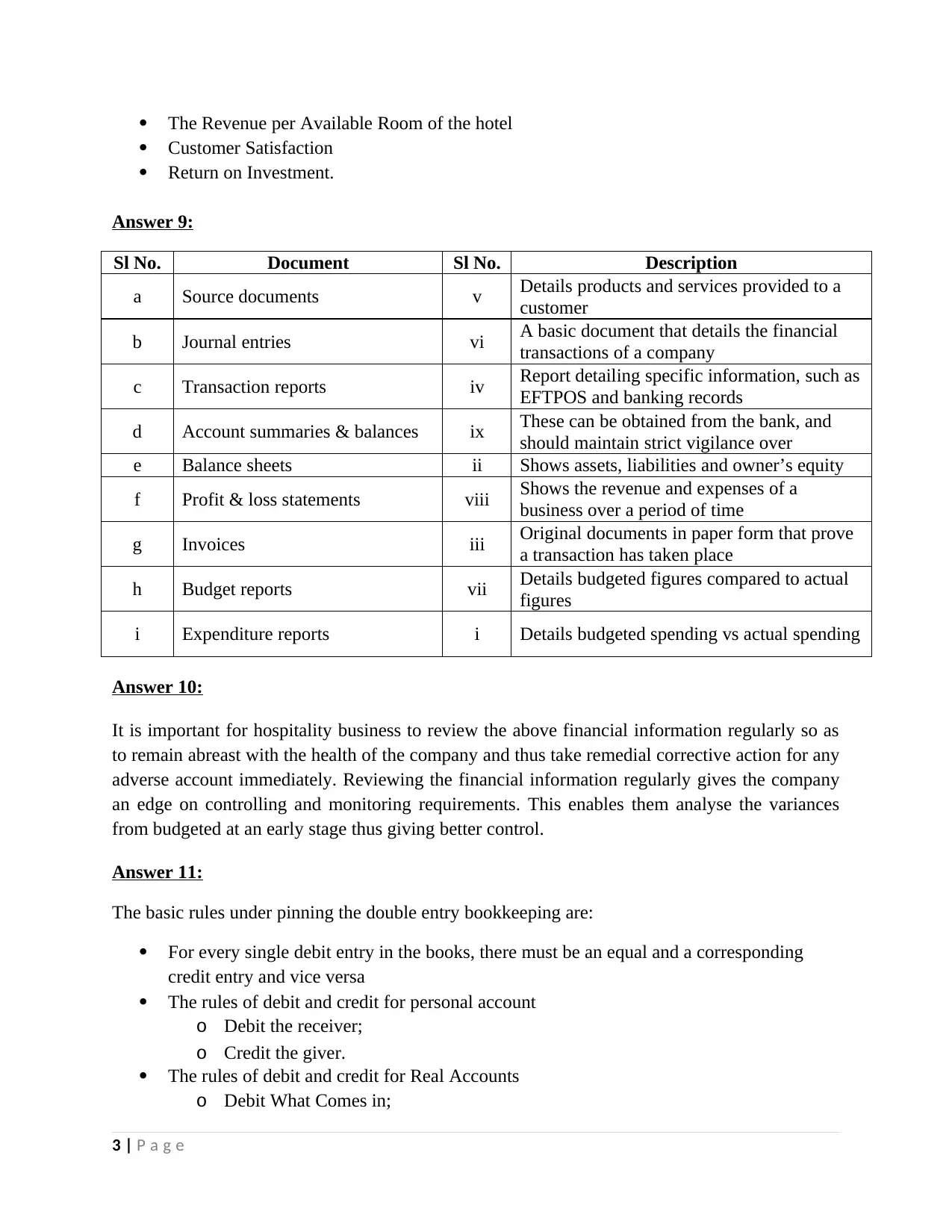
The Revenue per Available Room of the hotel
Customer Satisfaction
Return on Investment.
Answer 9:
Sl No. Document Sl No. Description
a Source documents v Details products and services provided to a
customer
b Journal entries vi A basic document that details the financial
transactions of a company
c Transaction reports iv Report detailing specific information, such as
EFTPOS and banking records
d Account summaries & balances ix These can be obtained from the bank, and
should maintain strict vigilance over
e Balance sheets ii Shows assets, liabilities and owner’s equity
f Profit & loss statements viii Shows the revenue and expenses of a
business over a period of time
g Invoices iii Original documents in paper form that prove
a transaction has taken place
h Budget reports vii Details budgeted figures compared to actual
figures
i Expenditure reports i Details budgeted spending vs actual spending
Answer 10:
It is important for hospitality business to review the above financial information regularly so as
to remain abreast with the health of the company and thus take remedial corrective action for any
adverse account immediately. Reviewing the financial information regularly gives the company
an edge on controlling and monitoring requirements. This enables them analyse the variances
from budgeted at an early stage thus giving better control.
Answer 11:
The basic rules under pinning the double entry bookkeeping are:
For every single debit entry in the books, there must be an equal and a corresponding
credit entry and vice versa
The rules of debit and credit for personal account
o Debit the receiver;
o Credit the giver.
The rules of debit and credit for Real Accounts
o Debit What Comes in;
3 | P a g e
Customer Satisfaction
Return on Investment.
Answer 9:
Sl No. Document Sl No. Description
a Source documents v Details products and services provided to a
customer
b Journal entries vi A basic document that details the financial
transactions of a company
c Transaction reports iv Report detailing specific information, such as
EFTPOS and banking records
d Account summaries & balances ix These can be obtained from the bank, and
should maintain strict vigilance over
e Balance sheets ii Shows assets, liabilities and owner’s equity
f Profit & loss statements viii Shows the revenue and expenses of a
business over a period of time
g Invoices iii Original documents in paper form that prove
a transaction has taken place
h Budget reports vii Details budgeted figures compared to actual
figures
i Expenditure reports i Details budgeted spending vs actual spending
Answer 10:
It is important for hospitality business to review the above financial information regularly so as
to remain abreast with the health of the company and thus take remedial corrective action for any
adverse account immediately. Reviewing the financial information regularly gives the company
an edge on controlling and monitoring requirements. This enables them analyse the variances
from budgeted at an early stage thus giving better control.
Answer 11:
The basic rules under pinning the double entry bookkeeping are:
For every single debit entry in the books, there must be an equal and a corresponding
credit entry and vice versa
The rules of debit and credit for personal account
o Debit the receiver;
o Credit the giver.
The rules of debit and credit for Real Accounts
o Debit What Comes in;
3 | P a g e
⊘ This is a preview!⊘
Do you want full access?
Subscribe today to unlock all pages.

Trusted by 1+ million students worldwide
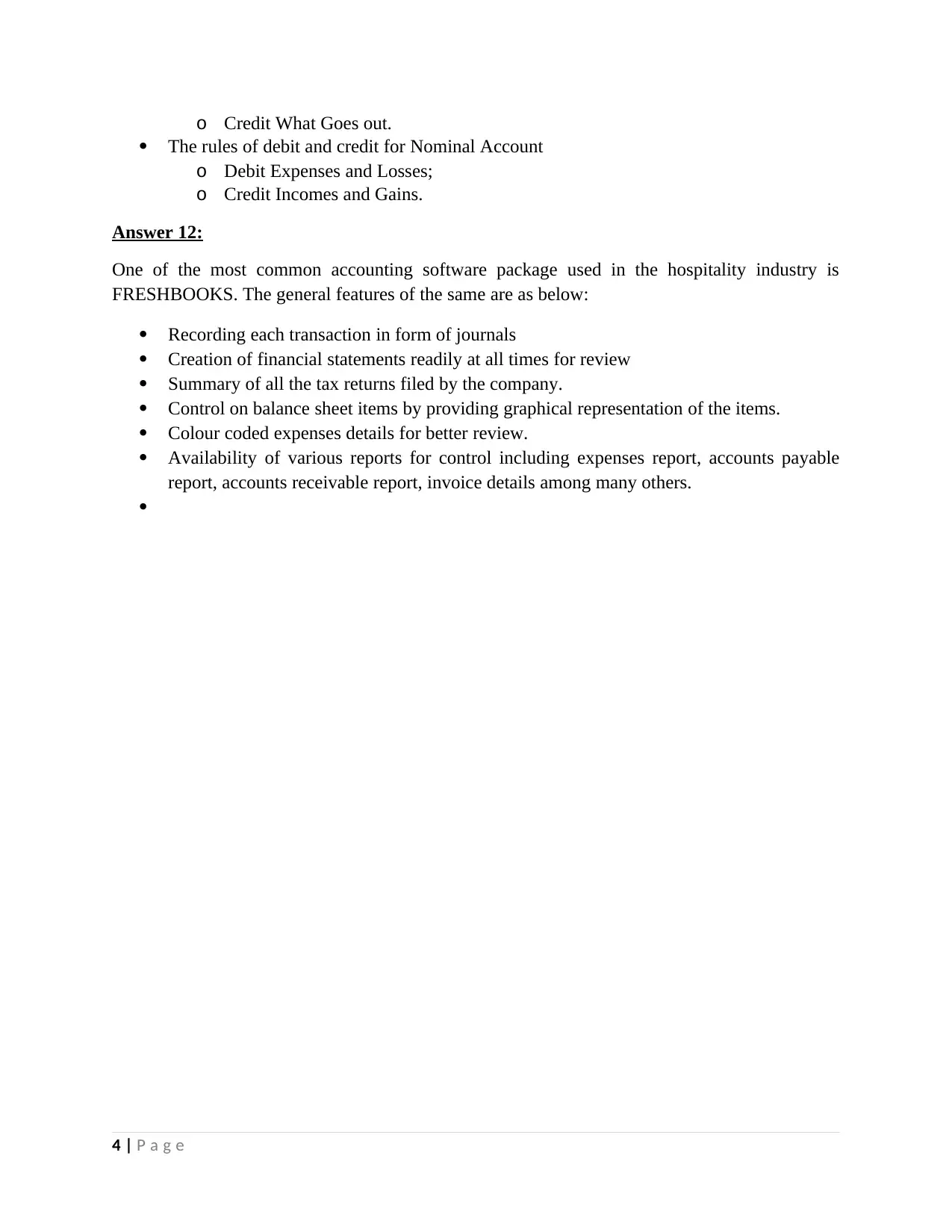
o Credit What Goes out.
The rules of debit and credit for Nominal Account
o Debit Expenses and Losses;
o Credit Incomes and Gains.
Answer 12:
One of the most common accounting software package used in the hospitality industry is
FRESHBOOKS. The general features of the same are as below:
Recording each transaction in form of journals
Creation of financial statements readily at all times for review
Summary of all the tax returns filed by the company.
Control on balance sheet items by providing graphical representation of the items.
Colour coded expenses details for better review.
Availability of various reports for control including expenses report, accounts payable
report, accounts receivable report, invoice details among many others.
4 | P a g e
The rules of debit and credit for Nominal Account
o Debit Expenses and Losses;
o Credit Incomes and Gains.
Answer 12:
One of the most common accounting software package used in the hospitality industry is
FRESHBOOKS. The general features of the same are as below:
Recording each transaction in form of journals
Creation of financial statements readily at all times for review
Summary of all the tax returns filed by the company.
Control on balance sheet items by providing graphical representation of the items.
Colour coded expenses details for better review.
Availability of various reports for control including expenses report, accounts payable
report, accounts receivable report, invoice details among many others.
4 | P a g e
Paraphrase This Document
Need a fresh take? Get an instant paraphrase of this document with our AI Paraphraser
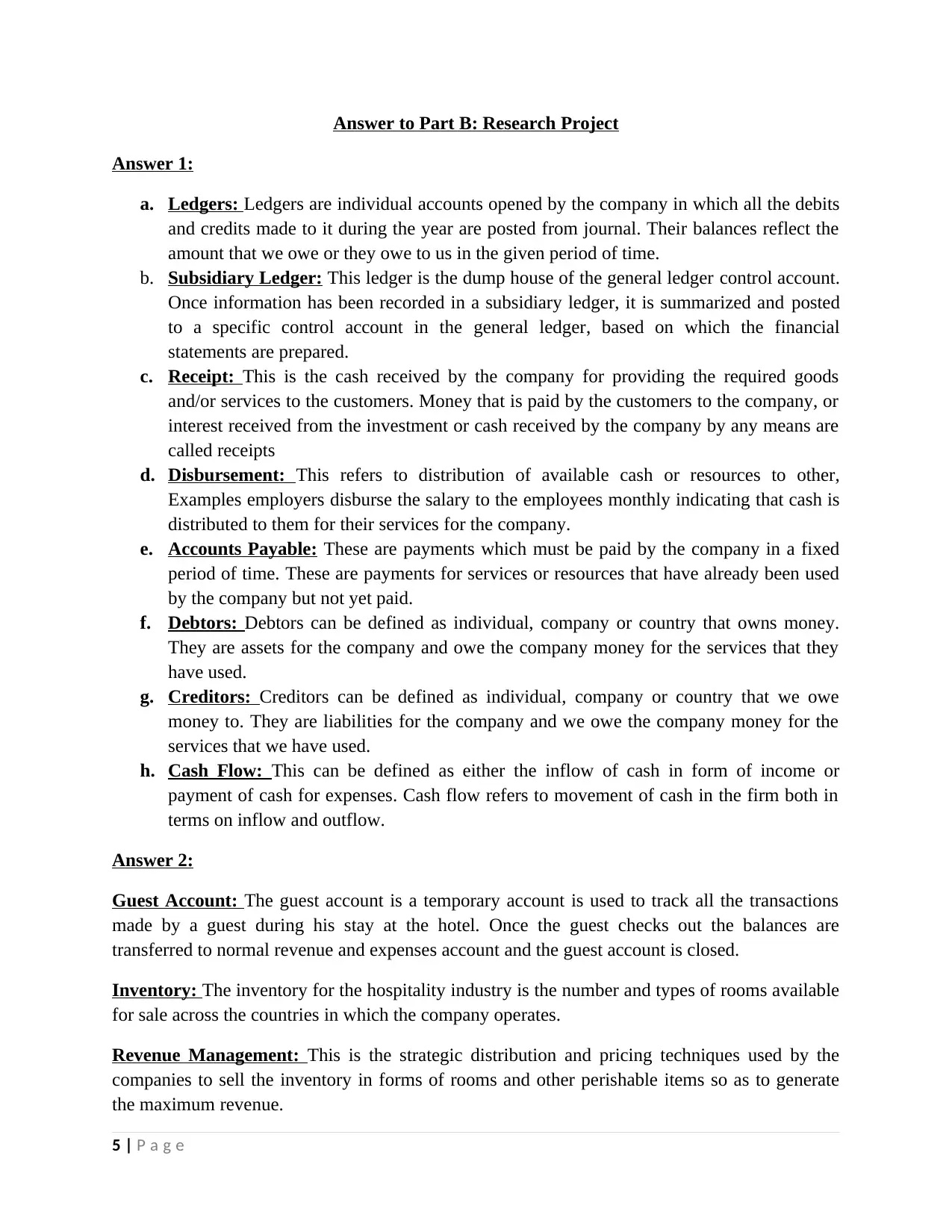
Answer to Part B: Research Project
Answer 1:
a. Ledgers: Ledgers are individual accounts opened by the company in which all the debits
and credits made to it during the year are posted from journal. Their balances reflect the
amount that we owe or they owe to us in the given period of time.
b. Subsidiary Ledger: This ledger is the dump house of the general ledger control account.
Once information has been recorded in a subsidiary ledger, it is summarized and posted
to a specific control account in the general ledger, based on which the financial
statements are prepared.
c. Receipt: This is the cash received by the company for providing the required goods
and/or services to the customers. Money that is paid by the customers to the company, or
interest received from the investment or cash received by the company by any means are
called receipts
d. Disbursement: This refers to distribution of available cash or resources to other,
Examples employers disburse the salary to the employees monthly indicating that cash is
distributed to them for their services for the company.
e. Accounts Payable: These are payments which must be paid by the company in a fixed
period of time. These are payments for services or resources that have already been used
by the company but not yet paid.
f. Debtors: Debtors can be defined as individual, company or country that owns money.
They are assets for the company and owe the company money for the services that they
have used.
g. Creditors: Creditors can be defined as individual, company or country that we owe
money to. They are liabilities for the company and we owe the company money for the
services that we have used.
h. Cash Flow: This can be defined as either the inflow of cash in form of income or
payment of cash for expenses. Cash flow refers to movement of cash in the firm both in
terms on inflow and outflow.
Answer 2:
Guest Account: The guest account is a temporary account is used to track all the transactions
made by a guest during his stay at the hotel. Once the guest checks out the balances are
transferred to normal revenue and expenses account and the guest account is closed.
Inventory: The inventory for the hospitality industry is the number and types of rooms available
for sale across the countries in which the company operates.
Revenue Management: This is the strategic distribution and pricing techniques used by the
companies to sell the inventory in forms of rooms and other perishable items so as to generate
the maximum revenue.
5 | P a g e
Answer 1:
a. Ledgers: Ledgers are individual accounts opened by the company in which all the debits
and credits made to it during the year are posted from journal. Their balances reflect the
amount that we owe or they owe to us in the given period of time.
b. Subsidiary Ledger: This ledger is the dump house of the general ledger control account.
Once information has been recorded in a subsidiary ledger, it is summarized and posted
to a specific control account in the general ledger, based on which the financial
statements are prepared.
c. Receipt: This is the cash received by the company for providing the required goods
and/or services to the customers. Money that is paid by the customers to the company, or
interest received from the investment or cash received by the company by any means are
called receipts
d. Disbursement: This refers to distribution of available cash or resources to other,
Examples employers disburse the salary to the employees monthly indicating that cash is
distributed to them for their services for the company.
e. Accounts Payable: These are payments which must be paid by the company in a fixed
period of time. These are payments for services or resources that have already been used
by the company but not yet paid.
f. Debtors: Debtors can be defined as individual, company or country that owns money.
They are assets for the company and owe the company money for the services that they
have used.
g. Creditors: Creditors can be defined as individual, company or country that we owe
money to. They are liabilities for the company and we owe the company money for the
services that we have used.
h. Cash Flow: This can be defined as either the inflow of cash in form of income or
payment of cash for expenses. Cash flow refers to movement of cash in the firm both in
terms on inflow and outflow.
Answer 2:
Guest Account: The guest account is a temporary account is used to track all the transactions
made by a guest during his stay at the hotel. Once the guest checks out the balances are
transferred to normal revenue and expenses account and the guest account is closed.
Inventory: The inventory for the hospitality industry is the number and types of rooms available
for sale across the countries in which the company operates.
Revenue Management: This is the strategic distribution and pricing techniques used by the
companies to sell the inventory in forms of rooms and other perishable items so as to generate
the maximum revenue.
5 | P a g e
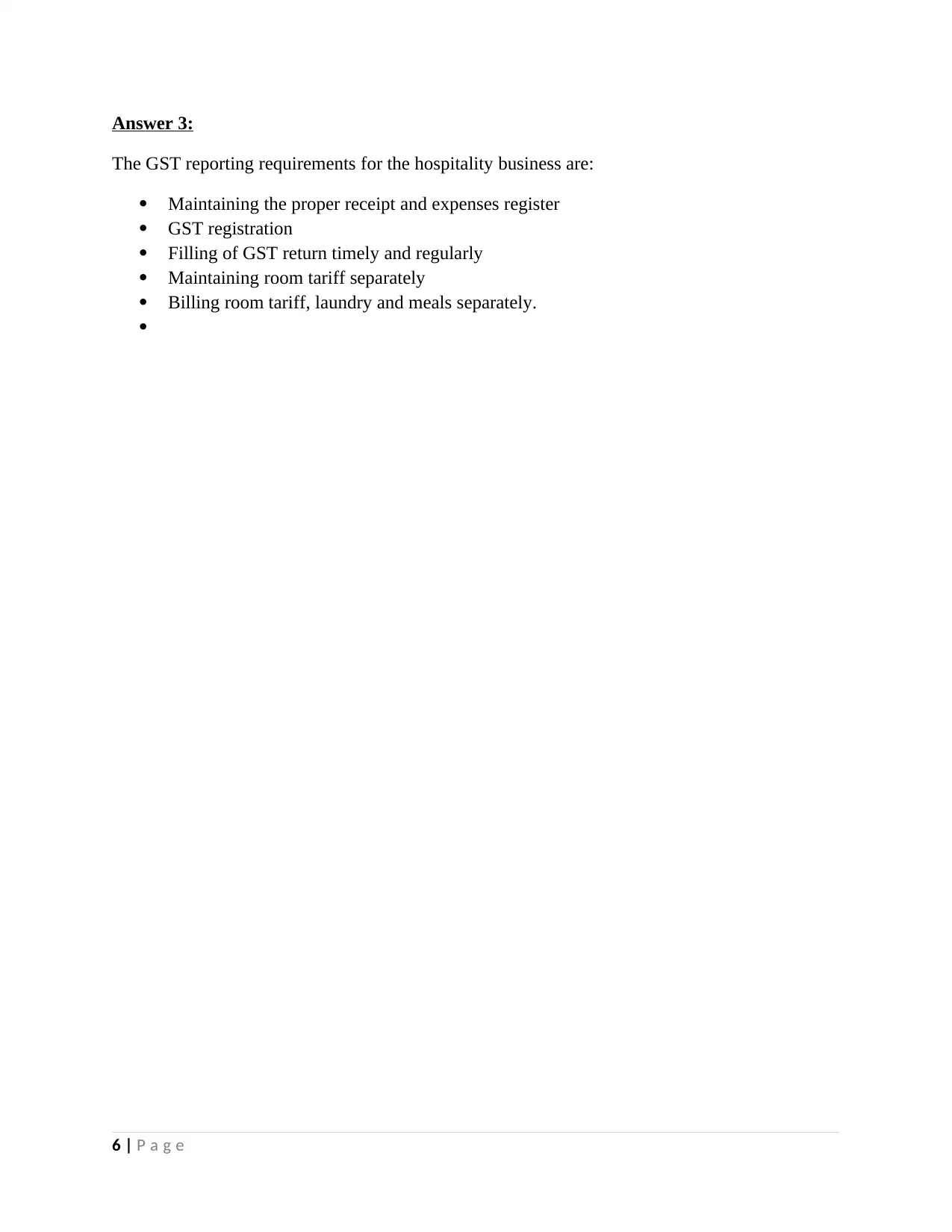
Answer 3:
The GST reporting requirements for the hospitality business are:
Maintaining the proper receipt and expenses register
GST registration
Filling of GST return timely and regularly
Maintaining room tariff separately
Billing room tariff, laundry and meals separately.
6 | P a g e
The GST reporting requirements for the hospitality business are:
Maintaining the proper receipt and expenses register
GST registration
Filling of GST return timely and regularly
Maintaining room tariff separately
Billing room tariff, laundry and meals separately.
6 | P a g e
⊘ This is a preview!⊘
Do you want full access?
Subscribe today to unlock all pages.

Trusted by 1+ million students worldwide
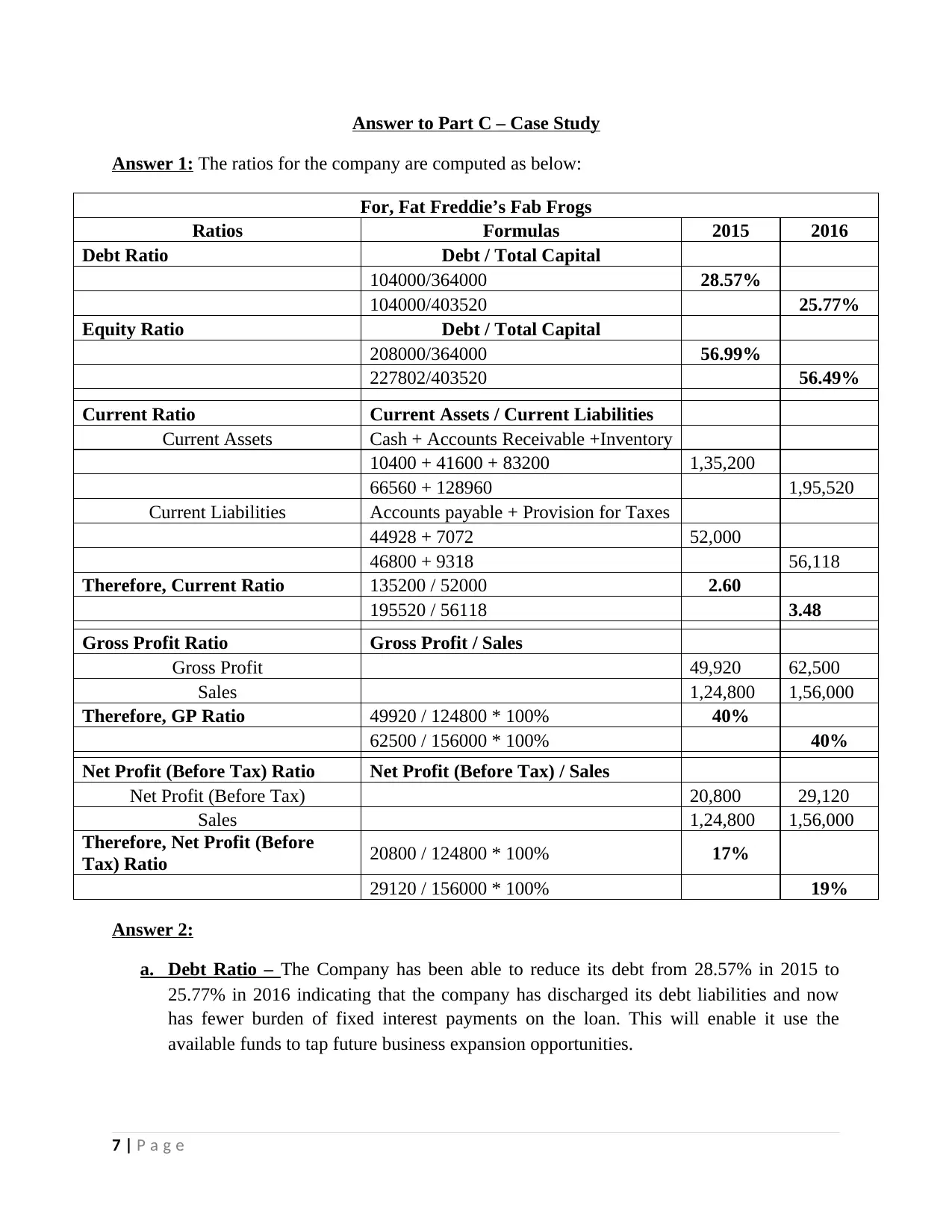
Answer to Part C – Case Study
Answer 1: The ratios for the company are computed as below:
For, Fat Freddie’s Fab Frogs
Ratios Formulas 2015 2016
Debt Ratio Debt / Total Capital
104000/364000 28.57%
104000/403520 25.77%
Equity Ratio Debt / Total Capital
208000/364000 56.99%
227802/403520 56.49%
Current Ratio Current Assets / Current Liabilities
Current Assets Cash + Accounts Receivable +Inventory
10400 + 41600 + 83200 1,35,200
66560 + 128960 1,95,520
Current Liabilities Accounts payable + Provision for Taxes
44928 + 7072 52,000
46800 + 9318 56,118
Therefore, Current Ratio 135200 / 52000 2.60
195520 / 56118 3.48
Gross Profit Ratio Gross Profit / Sales
Gross Profit 49,920 62,500
Sales 1,24,800 1,56,000
Therefore, GP Ratio 49920 / 124800 * 100% 40%
62500 / 156000 * 100% 40%
Net Profit (Before Tax) Ratio Net Profit (Before Tax) / Sales
Net Profit (Before Tax) 20,800 29,120
Sales 1,24,800 1,56,000
Therefore, Net Profit (Before
Tax) Ratio 20800 / 124800 * 100% 17%
29120 / 156000 * 100% 19%
Answer 2:
a. Debt Ratio – The Company has been able to reduce its debt from 28.57% in 2015 to
25.77% in 2016 indicating that the company has discharged its debt liabilities and now
has fewer burden of fixed interest payments on the loan. This will enable it use the
available funds to tap future business expansion opportunities.
7 | P a g e
Answer 1: The ratios for the company are computed as below:
For, Fat Freddie’s Fab Frogs
Ratios Formulas 2015 2016
Debt Ratio Debt / Total Capital
104000/364000 28.57%
104000/403520 25.77%
Equity Ratio Debt / Total Capital
208000/364000 56.99%
227802/403520 56.49%
Current Ratio Current Assets / Current Liabilities
Current Assets Cash + Accounts Receivable +Inventory
10400 + 41600 + 83200 1,35,200
66560 + 128960 1,95,520
Current Liabilities Accounts payable + Provision for Taxes
44928 + 7072 52,000
46800 + 9318 56,118
Therefore, Current Ratio 135200 / 52000 2.60
195520 / 56118 3.48
Gross Profit Ratio Gross Profit / Sales
Gross Profit 49,920 62,500
Sales 1,24,800 1,56,000
Therefore, GP Ratio 49920 / 124800 * 100% 40%
62500 / 156000 * 100% 40%
Net Profit (Before Tax) Ratio Net Profit (Before Tax) / Sales
Net Profit (Before Tax) 20,800 29,120
Sales 1,24,800 1,56,000
Therefore, Net Profit (Before
Tax) Ratio 20800 / 124800 * 100% 17%
29120 / 156000 * 100% 19%
Answer 2:
a. Debt Ratio – The Company has been able to reduce its debt from 28.57% in 2015 to
25.77% in 2016 indicating that the company has discharged its debt liabilities and now
has fewer burden of fixed interest payments on the loan. This will enable it use the
available funds to tap future business expansion opportunities.
7 | P a g e
Paraphrase This Document
Need a fresh take? Get an instant paraphrase of this document with our AI Paraphraser
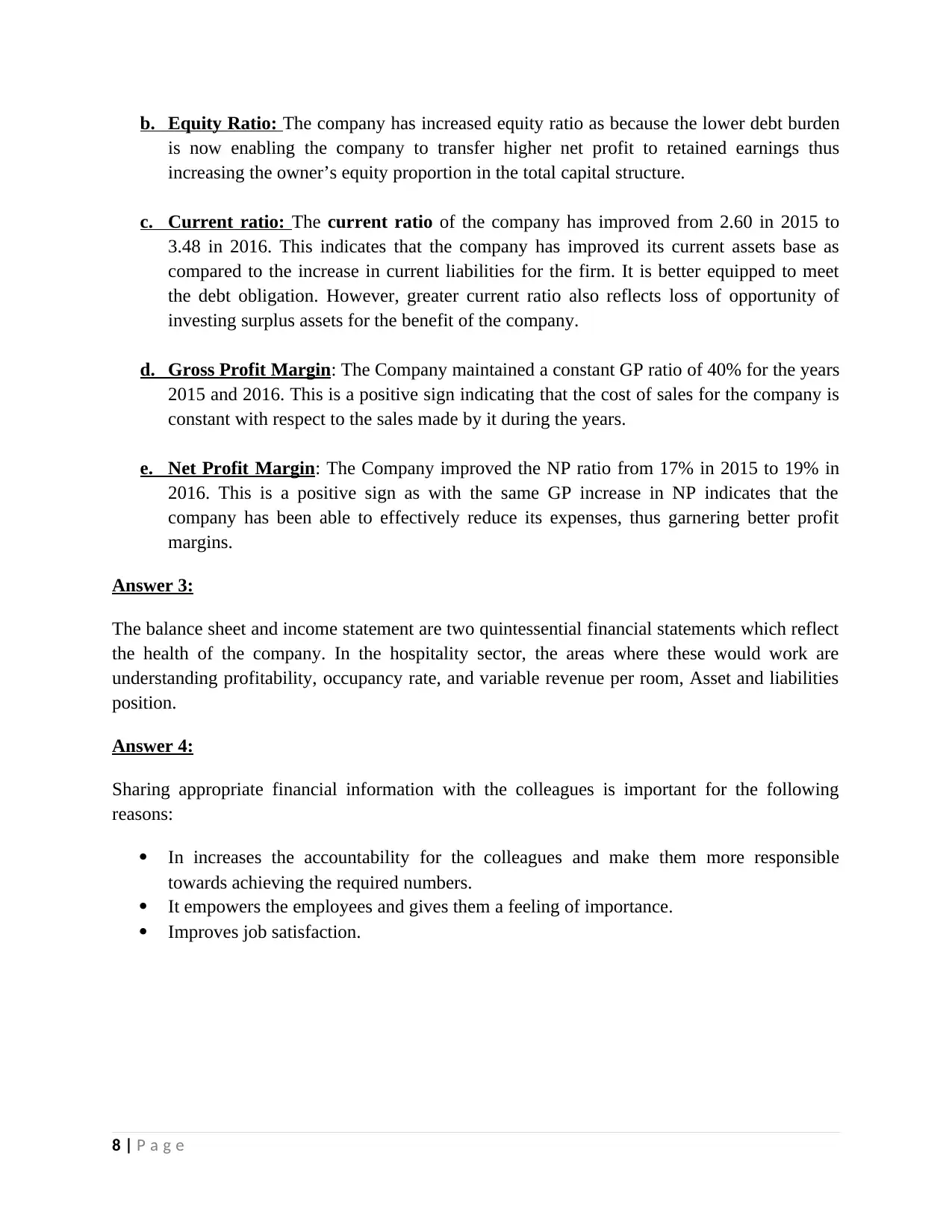
b. Equity Ratio: The company has increased equity ratio as because the lower debt burden
is now enabling the company to transfer higher net profit to retained earnings thus
increasing the owner’s equity proportion in the total capital structure.
c. Current ratio: The current ratio of the company has improved from 2.60 in 2015 to
3.48 in 2016. This indicates that the company has improved its current assets base as
compared to the increase in current liabilities for the firm. It is better equipped to meet
the debt obligation. However, greater current ratio also reflects loss of opportunity of
investing surplus assets for the benefit of the company.
d. Gross Profit Margin: The Company maintained a constant GP ratio of 40% for the years
2015 and 2016. This is a positive sign indicating that the cost of sales for the company is
constant with respect to the sales made by it during the years.
e. Net Profit Margin: The Company improved the NP ratio from 17% in 2015 to 19% in
2016. This is a positive sign as with the same GP increase in NP indicates that the
company has been able to effectively reduce its expenses, thus garnering better profit
margins.
Answer 3:
The balance sheet and income statement are two quintessential financial statements which reflect
the health of the company. In the hospitality sector, the areas where these would work are
understanding profitability, occupancy rate, and variable revenue per room, Asset and liabilities
position.
Answer 4:
Sharing appropriate financial information with the colleagues is important for the following
reasons:
In increases the accountability for the colleagues and make them more responsible
towards achieving the required numbers.
It empowers the employees and gives them a feeling of importance.
Improves job satisfaction.
8 | P a g e
is now enabling the company to transfer higher net profit to retained earnings thus
increasing the owner’s equity proportion in the total capital structure.
c. Current ratio: The current ratio of the company has improved from 2.60 in 2015 to
3.48 in 2016. This indicates that the company has improved its current assets base as
compared to the increase in current liabilities for the firm. It is better equipped to meet
the debt obligation. However, greater current ratio also reflects loss of opportunity of
investing surplus assets for the benefit of the company.
d. Gross Profit Margin: The Company maintained a constant GP ratio of 40% for the years
2015 and 2016. This is a positive sign indicating that the cost of sales for the company is
constant with respect to the sales made by it during the years.
e. Net Profit Margin: The Company improved the NP ratio from 17% in 2015 to 19% in
2016. This is a positive sign as with the same GP increase in NP indicates that the
company has been able to effectively reduce its expenses, thus garnering better profit
margins.
Answer 3:
The balance sheet and income statement are two quintessential financial statements which reflect
the health of the company. In the hospitality sector, the areas where these would work are
understanding profitability, occupancy rate, and variable revenue per room, Asset and liabilities
position.
Answer 4:
Sharing appropriate financial information with the colleagues is important for the following
reasons:
In increases the accountability for the colleagues and make them more responsible
towards achieving the required numbers.
It empowers the employees and gives them a feeling of importance.
Improves job satisfaction.
8 | P a g e
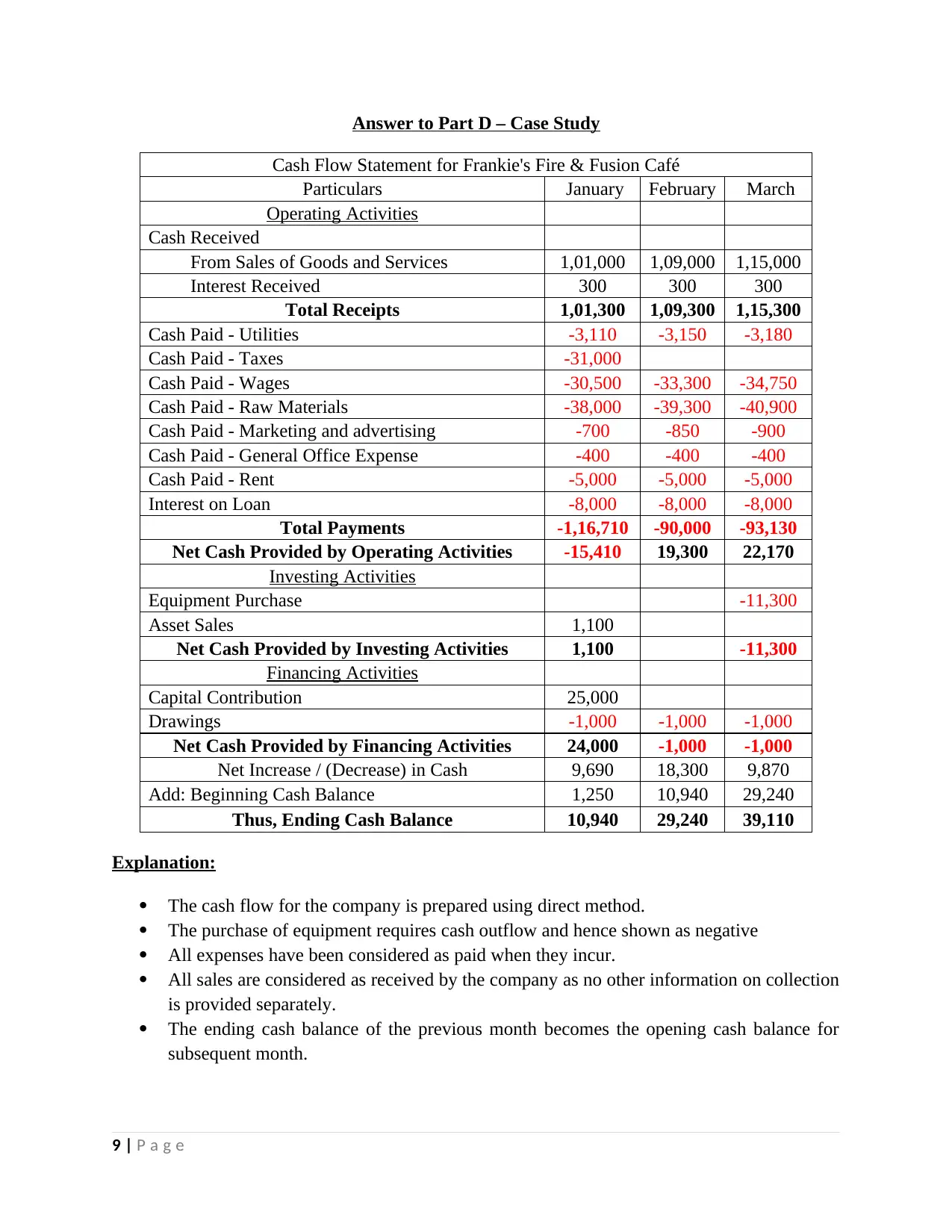
Answer to Part D – Case Study
Cash Flow Statement for Frankie's Fire & Fusion Café
Particulars January February March
Operating Activities
Cash Received
From Sales of Goods and Services 1,01,000 1,09,000 1,15,000
Interest Received 300 300 300
Total Receipts 1,01,300 1,09,300 1,15,300
Cash Paid - Utilities -3,110 -3,150 -3,180
Cash Paid - Taxes -31,000
Cash Paid - Wages -30,500 -33,300 -34,750
Cash Paid - Raw Materials -38,000 -39,300 -40,900
Cash Paid - Marketing and advertising -700 -850 -900
Cash Paid - General Office Expense -400 -400 -400
Cash Paid - Rent -5,000 -5,000 -5,000
Interest on Loan -8,000 -8,000 -8,000
Total Payments -1,16,710 -90,000 -93,130
Net Cash Provided by Operating Activities -15,410 19,300 22,170
Investing Activities
Equipment Purchase -11,300
Asset Sales 1,100
Net Cash Provided by Investing Activities 1,100 -11,300
Financing Activities
Capital Contribution 25,000
Drawings -1,000 -1,000 -1,000
Net Cash Provided by Financing Activities 24,000 -1,000 -1,000
Net Increase / (Decrease) in Cash 9,690 18,300 9,870
Add: Beginning Cash Balance 1,250 10,940 29,240
Thus, Ending Cash Balance 10,940 29,240 39,110
Explanation:
The cash flow for the company is prepared using direct method.
The purchase of equipment requires cash outflow and hence shown as negative
All expenses have been considered as paid when they incur.
All sales are considered as received by the company as no other information on collection
is provided separately.
The ending cash balance of the previous month becomes the opening cash balance for
subsequent month.
9 | P a g e
Cash Flow Statement for Frankie's Fire & Fusion Café
Particulars January February March
Operating Activities
Cash Received
From Sales of Goods and Services 1,01,000 1,09,000 1,15,000
Interest Received 300 300 300
Total Receipts 1,01,300 1,09,300 1,15,300
Cash Paid - Utilities -3,110 -3,150 -3,180
Cash Paid - Taxes -31,000
Cash Paid - Wages -30,500 -33,300 -34,750
Cash Paid - Raw Materials -38,000 -39,300 -40,900
Cash Paid - Marketing and advertising -700 -850 -900
Cash Paid - General Office Expense -400 -400 -400
Cash Paid - Rent -5,000 -5,000 -5,000
Interest on Loan -8,000 -8,000 -8,000
Total Payments -1,16,710 -90,000 -93,130
Net Cash Provided by Operating Activities -15,410 19,300 22,170
Investing Activities
Equipment Purchase -11,300
Asset Sales 1,100
Net Cash Provided by Investing Activities 1,100 -11,300
Financing Activities
Capital Contribution 25,000
Drawings -1,000 -1,000 -1,000
Net Cash Provided by Financing Activities 24,000 -1,000 -1,000
Net Increase / (Decrease) in Cash 9,690 18,300 9,870
Add: Beginning Cash Balance 1,250 10,940 29,240
Thus, Ending Cash Balance 10,940 29,240 39,110
Explanation:
The cash flow for the company is prepared using direct method.
The purchase of equipment requires cash outflow and hence shown as negative
All expenses have been considered as paid when they incur.
All sales are considered as received by the company as no other information on collection
is provided separately.
The ending cash balance of the previous month becomes the opening cash balance for
subsequent month.
9 | P a g e
⊘ This is a preview!⊘
Do you want full access?
Subscribe today to unlock all pages.

Trusted by 1+ million students worldwide
1 out of 9
Related Documents
Your All-in-One AI-Powered Toolkit for Academic Success.
+13062052269
info@desklib.com
Available 24*7 on WhatsApp / Email
![[object Object]](/_next/static/media/star-bottom.7253800d.svg)
Unlock your academic potential
Copyright © 2020–2025 A2Z Services. All Rights Reserved. Developed and managed by ZUCOL.



